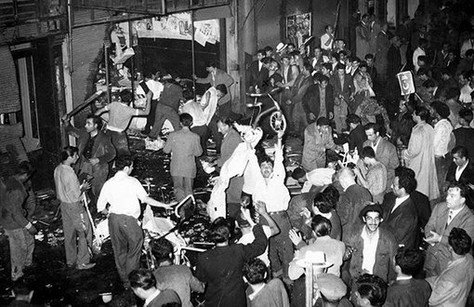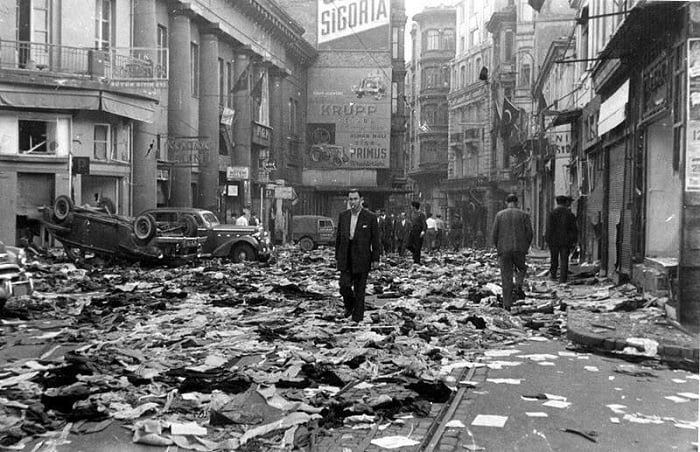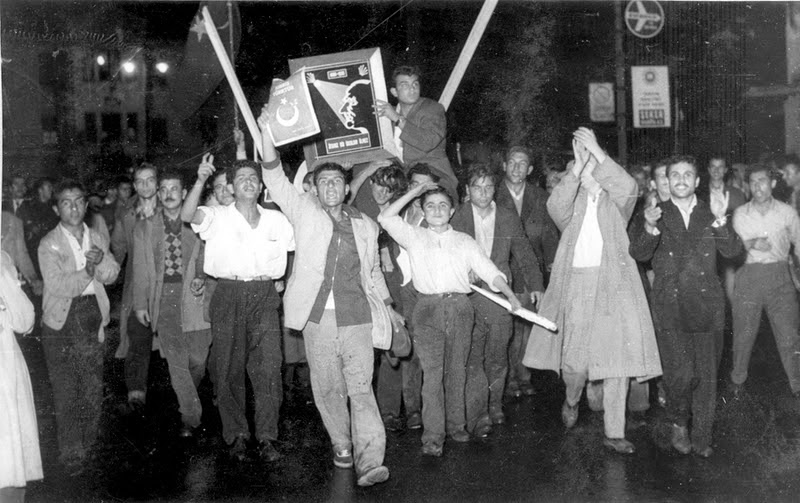How can we address and come to terms with the events of September 6-7, 1955, widely known as ‘the Istanbul Pogrom’? There has been extensive literature and discussion surrounding the ‘incidents’ of those days in Turkey. It has become customary to view September 6-7 as a regrettable and unwanted part of our history that we hope will never be repeated. Given the amount of information and public dialogue about it, can we confidently say that we have truly confronted and dealt with the tragic ‘events’ of September 6-7? Is it possible to regard September 6-7 as a dark but now closed chapter in our history? If so, what is the political significance of discussing it today? Foti Benlisoy, a member of the Greek community in Istanbul and one of the owners of the publishing house Istos, addresses this issue.
Since the establishment of Greece and Turkey as nation states, the battle for domination in the area between the two ruling classes has been ongoing. But after World War II, Greek-Turkish relations experienced a short period of significant improvement. The two nations forged political and military collaborations within the context of the Cold War. As allies against the perceived “red threat from the north,” both countries endorsed the Truman Doctrine in 1947, participated in the Marshall Plan, and became members of the Council of Europe (Greece in ’49, Turkey in ’50).
The Cyprus Question
However, in the mid-1950s, events took a sharp turn. Greece’s attempt to bring the Cyprus issue to the forefront of the United Nations (UN) agenda prompted Turkey to become involved, despite its previous limited interest in Cyprus. The encouragement from British imperialism played a significant role in this sudden shift in Turkish politics. Britain saw Turkish involvement in the Cyprus question as aligning with its own interests and actively sought to escalate the Greek-British dispute into a trilateral issue, thereby drawing Turkey into the fray.
At the same time, EOKA (National Organisation of Cypriot Fighters) was formed in January 1955. On April 1st, EOKA started an armed campaign against British rule, with a goal to impose Enosis (unification with Greece). The initial attacks against government buildings and the police, ultimately included also attacks on Turkish Cypriot police officers which escalated tensions. This prompted a response from Turkish Cypriots that established the Turkish Resistance Organisation (TMT) in 1957, aiming at Taksim (the division of Cyprus).
As the crisis in Cyprus unfolded, Ankara tried to use the Greek Orthodox community in Turkey as leverage, a means of exerting pressure on Greece. The Turkish government believed that this pressure on the Greek minority in Turkey would make Greece more accommodating in the Cyprus question.
Concurrently, starting in 1954, Turkey’s economic boom of 1950-1953 began to wane. The growth rate declined from 13% to 4%, and the trade deficit in 1955 was eight times higher than that of 1950. Despite its victory in the 1954 elections, the Democrat Party began to lose support due to the deteriorating living standards. Consequently, the government adopted an increasingly authoritarian policy, which generated opposition. The Menderes government, grappling with economic and political crises, sought to divert Turkish public attention towards “national issues,” primarily the Cyprus dispute.
On June 30, 1955, the British government, under Prime Minister Anthony Eden, invited Greece and Turkey to participate in a conference focused on “security issues in the Eastern Mediterranean.” The Turkish government needed to convince the international public opinion that its delayed involvement in the Cyprus issue did not reflect indifference. It aimed to demonstrate that Turkish public sentiment remained engaged with developments and expressed concerns for the Turkish Cypriots.

A nationalist campaign
As the Cyprus dispute gained public attention, particularly from 1955 onwards, a nationalist campaign was launched, targeting the Ecumenical Patriarchate and the Greek Orthodox minority. The Turkish press played a central role in creating an atmosphere in which the Greek minority was portrayed as the “internal enemy.” During this period, articles were published comparing the conditions of the respective minorities in Western Thrace and Istanbul, concluding that while Muslims in Western Thrace faced systematic oppression, the Orthodox community in Istanbul thrived.
In the summer of 1955, as the tripartite conference approached, the Turkish press and political groups intensified their attacks on the Greek minority. Starting from the end of August, nationalist and anti-minority incidents occurred daily. People speaking Greek in public transportation were harassed, and personal disputes took on national overtones, often leading to police involvement under charges of “offending Turkishness”.
On August 29, the tripartite conference began in London, and tensions grew even more. Therefore, despite later attempts to portray the events as “unforeseeable” by the authorities, by the beginning of September, an explosive situation had already developed.
The “Cyprus is Turkish” association (Kıbrıs Türktür Cemiyeti- KTC) played a pivotal role in organizing and executing the 6-7 September pogrom. The KTC was established in August 1954 with the encouragement of nationalist student associations to defend the Turkish community of Cyprus and mobilize Turkish people for the Cyprus question. The association had enjoyed government support since its inception, with Hikmet Bil, the association’s president and reporter at the newspaper Hürriyet, closely connected to PM Menderes’ inner circle. The government largely financed the association. Numerous local KTC organizations were established and staffed by members of the Democratic Party (DP). Due to the DP’s organizational network, the KTC quickly expanded not only in Istanbul but also across the country.

The events
On September 6, 1955, the newspaper İstanbul Ekspres published a fake news story, claiming that Greeks have bombed the Turkish Consulate in Thessaloniki (situated in the house where Kemal Ataturk was born). It was later revealed that the bomb was planted by a Turkish person working for the consulate, who was arrested and confessed.
Later that night, a demonstration began at Taksim Square, which eventually escalated into looting non-Muslim-owned shops along Istiklal Avenue in Beyoğlu (Pera). Subsequently, large groups of demonstrators launched attacks on shops, houses, churches, schools and cemeteries in almost all of the districts with Greek communities. An estimated 100,000 people participated in these riots.
The attacks occurred almost simultaneously and in a coordinated manner, suggesting a predetermined plan. There are indications that individual leaders were given “target lists” to execute the plan. Furthermore, there is ample evidence to support claims that demonstrators were transported not only from Istanbul districts but also from rural areas. Many reports confirm the presence of representatives from the Democrat Party organizations among the instigators. Local Democrat Party organizations and nationalist trade unions played a significant role in organizing the attacks and supplying the rioters with weapons such as crowbars, clubs and petrol. It is believed that the relatively low number of injuries and fatalities, considering the scale of the events, was a result of instructions given to the perpetrators to avoid causing physical harm. The security forces and even most of the firefighters did not respond to pleas for protection and there is a substantial number of testimonies indicating that they either aided the rioters or actively participated in the violence.
This onslaught resulted in approximately 15 fatalities. It is believed that around 200 women were raped by the attackers during the night of September 6-7.
In the aftermath of the riots, martial law was imposed in Istanbul, İzmir and Ankara. Three military courts were established in Istanbul. During the trials, the involvement of members of the Democrat Party, the government and the security police was disregarded. Despite initial accusations against the “Cyprus is Turkish” Association (KTC), its members were ultimately cleared of charges.
The riots had indeed certain social characteristics. Many observers noted that the perpetrators primarily came from lower social strata while they attacked the “modern” shops of Pera. The government used this social aspect of the riots to deflect any responsibility.
However, the situation is more nuanced. Contrary to the stereotype perpetuated by Turkish nationalism but also by the Greek literature of the “lost homelands,” not all Greeks in Istanbul were part of the bourgeoisie of Beyoğlu. Therefore, the events of September cannot be reduced to a simple “class battle” between the “infidel” Pera bourgeoisie and the Muslim/Turkish countryside. Many journalists of the time largely ignored the events in the districts where the poorest Greek communities resided.
The Menderes government attributed the events to a communist conspiracy and arrested 48 individuals on September 7, claiming they were communists. However, the theory of a communist conspiracy, common during the Cold War period, was not at all convincing. The events were clearly driven by nationalism and the involvement of anti-communist, nationalist circles was evident. Consequently, in late December, the arrested individuals labeled as “communists” were released without explanation.

Aftermath
The government leveraged the riots as a pretext to tighten restrictions on opposition groups and the press. This strategy allowed the government to conceal evidence that could implicate its involvement while imposing martial law and suppressing freedom of speech, ultimately aiming to deflect responsibility for the riots and shift the blame onto others.
Following the coup d’état on May 27, 1960, the riots became the subject of a specific trial, part of the proceedings against the Menderes government, held on the Plati Island (Yassıada). Ultimately, Menderes and the Foreign Minister Zorlu were convicted in connection with the events of September.
For the majority of the Greek community, these events served as definitive proof that they would never be fully accepted as equal Turkish citizens and would continually face discrimination, regardless of the government in power.
Continuity in the Turkish state
The role of the ruling Democrat Party (DP) in orchestrating the September 6-7 pogrom was obvious. DP provincial and district organizations not only actively participated in all phases of the pogrom but also took leadership roles in it. The “Cyprus is Turkish Society,” which played a pivotal role in the unfolding of these “events,” essentially operated as a front organization of the DP. Consequently, it is clear how Adnan Menderes and his associates orchestrated this anti-Greek pogrom.
In this context, it is evident that there is continuity within the Turkish state on how non-Muslim and not-Turkish populations are treated. Actions and attacks with state support against non-Muslim communities, despite internal disagreements among rulers and different factions within the state, have essentially been continuous since the foundation of the Turkish state. From Abdulhamid’s Hamidiye Regiments [1] to the Committee of Union and Progress’ Special Organization [2], from the 1909 Adana massacre [3] to the 1915 genocide [4], from the 1894-96 massacres [5] to Hrant Dink [6], from İsmet İnönü [7] to the Komitacı (Revolutionary) Celal Bayar [8], from ‘Ergenekon’ [9] to the AKP [10], the effort to present a ‘mighty’ Turkish state is marked by violence against minorities.
‘Closed chapter’?
Can there be an honest claim that there has been confrontation with this past? Has the Turkish state addressed the events of September 6-7 and moved on?
Perhaps, a better phrasing of the question is, can such a claim hold when we continue to witness anti-Kurdish (and more recently, anti-Alevi) acts of violence, including incidents that resemble mini-pogroms? Is it possible to speak of true confrontation with the past when trials related to past pogroms or similar events still hold a prominent place in our nationalist discourse? It’s crucial to remember that what we label as ‘confronting the past’ isn’t merely a passive recollection of some distant historical event; instead, it involves reevaluating that past within the context of our present reality.
We can only genuinely begin to confront this history when we recognize the parallels between the night of September 6-7 and attacks against Kurds in various parts of the country today. Otherwise, what is often referred to as ‘confrontation’ with the events of September 6-7 may remain nothing more than hollow expressions, a product of idealized middle-class nostalgia for Istanbul’s cosmopolitan past.
[1] Regiments of Abdulhamit (Sultan of Ottoman Empire between 1876 – 1912) purposely established for the massacres of Armenians in the mid-1890s.
[2] From 1913 to 1918, the Committee of Union and Progress ruled the empire as an authoritarian one-party state and its Special Organization (Teşkilat-ı Mahsusa) committed genocides against the Armenian, Greek and Assyrian peoples as part of a broader policy of ethnic cleansing during the late Ottoman period.
[3] On April 14, 1909, Ottoman Turks killed 15,000–30,000 Armenian Christians, in the Adana Vilayeti.
[4] Systematic destruction of the Armenian people and identity in the Ottoman Empire during World War I.
[5] Armenian Massacres of 1894-6 mainly committed by Hamidiye Regiments.
[6] An Armenian intellectual and writer who was assassinated by a Turkish nationalist on January 19, 2007.
[7] Second President of the Turkish Republic from 1938 to 1950.
[8] The massacre in Dersim, where official reports state that 13,000 people were killed when the state bombed from the air and attacked from the ground, occurred when Celal Bayar was the prime minister.
[9] Ultranationalist military group who is believed to have ties with military and security forces and suspected to kill Kurdish business people and intellectuals during 1990’s.
[10] The current leading political party, governing for over 20 years.



